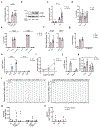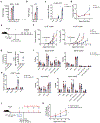Interleukin-23 engineering improves CAR T cell function in solid tumors
- PMID: 32015548
- PMCID: PMC7466194
- DOI: 10.1038/s41587-019-0398-2
Interleukin-23 engineering improves CAR T cell function in solid tumors
Abstract
Cytokines that stimulate T cell proliferation, such as interleukin (IL)-15, have been explored as a means of boosting the antitumor activity of chimeric antigen receptor (CAR) T cells. However, constitutive cytokine signaling in T cells and activation of bystander cells may cause toxicity. IL-23 is a two-subunit cytokine known to promote proliferation of memory T cells and T helper type 17 cells. We found that, upon T cell antigen receptor (TCR) stimulation, T cells upregulated the IL-23 receptor and the IL-23α p19 subunit, but not the p40 subunit. We engineered expression of the p40 subunit in T cells (p40-Td cells) and obtained selective proliferative activity in activated T cells via autocrine IL-23 signaling. In comparison to CAR T cells, p40-Td CAR T cells showed improved antitumor capacity in vitro, with increased granzyme B and decreased PD-1 expression. In two xenograft and two syngeneic solid tumor mouse models, p40-Td CAR T cells showed superior efficacy in comparison to CAR T cells and attenuated side effects in comparison to CAR T cells expressing IL-18 or IL-15.
Figures






References
-
- Garber K Driving T-cell immunotherapy to solid tumors. Nat Biotechnol 36, 215–219 (2018). - PubMed
Method-Only References
-
- Du HHK; Ahn S; Kren NP; Montgomery SA; Wang XH; Tiruthani K; Mirlekar R; Michaud D; Greene K; Herrera SG; Sun C; Chen YH; Xu Y; Ma XC; Ferrone CR; Pylayeva-Gupta Y; and Yeh JJ; Liu RH; Savoldo B; Ferrone S; Dotti G. Antitumor Responses in the Absence of Toxicity in Solid Tumors by Targeting B7-H3 Via Chimeric Antigen Receptor T Cells Cancer Cell (2018). - PMC - PubMed
Publication types
MeSH terms
Substances
Grants and funding
LinkOut - more resources
Full Text Sources
Other Literature Sources
Medical
Miscellaneous

